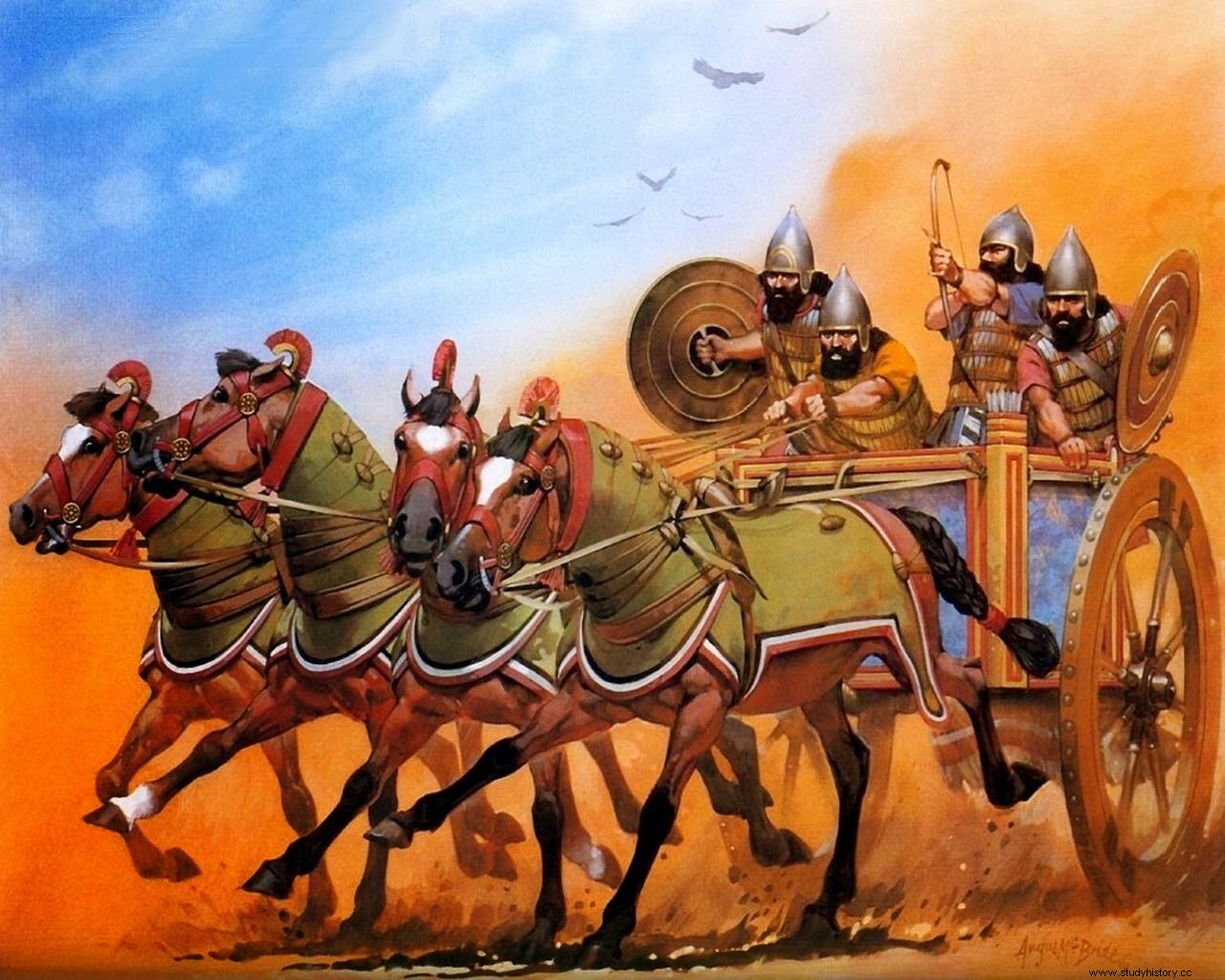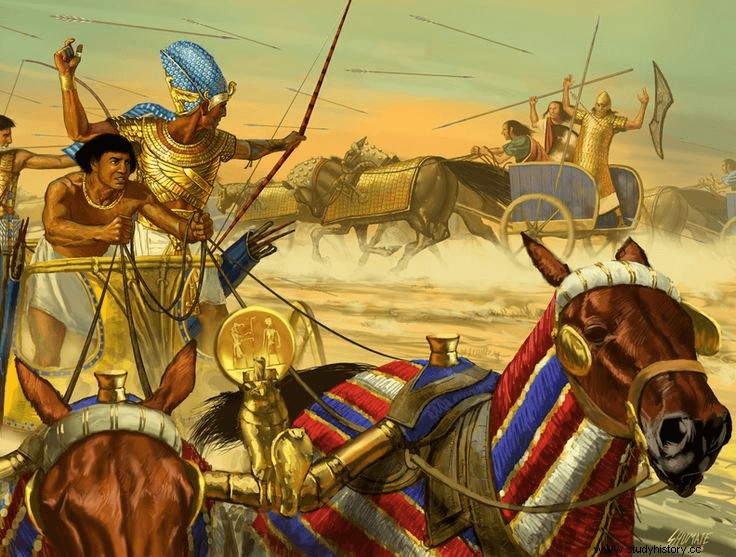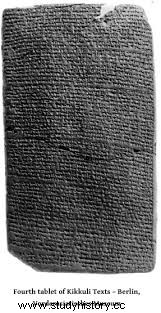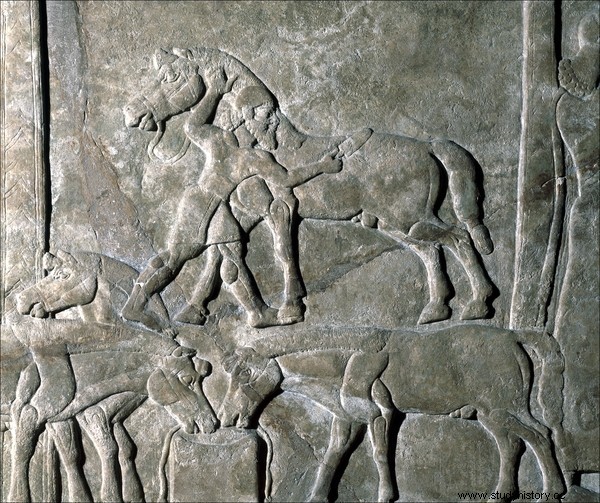Thanks to studies carried out in Kazakhstan, we know that the horse was domesticated a long time ago, more than 7,000 years ago. Although at first it was used mainly for skins and food, over time it was discovered to be very useful for carrying weights and pulling carts, and of course, a great advantage in war, of course. In China, in the ancient kingdom of Shang, there is evidence of the use of horses pulling war chariots, even before riding was learned. In Sumeria, chariots were pulled by onagers, but this animal was difficult to tame and quite stubborn once trained, so the Assyrians ended up preferring hacks to pull their war machines. Over time, various peoples of antiquity rode on horses, introducing cavalry in battles. Of course, without stirrups, no matter how much Hollywood insists on showing the opposite.

Industrial espionage must have appeared at about the same time as the repeating stone axe. And it is that if your neighbors in the cave next door invented a sharper and more resistant spear, they had a clear advantage when it came to bringing steaks home. This basic idea is applicable to the world of war. The Sumerian chariot was slow and not very manoeuvrable, so it is thought that it was only used to show off in parades or chase the defeated enemy. Those who began to use horses in war chariots discovered that their machines went faster than those of the opposite, pulled by onagers or donkeys, and that from that platform the act of throwing javelins and arrows was so explosive that it could be achieved that the Otherwise you will panic. In a way, the concepts of “blitzkrieg were discovered. ” (lightning war) and “every man for himself”. But the problem arises when two important kingdoms have chariots and horses in abundance, and if one monarch habitually mints the other's mother and vice versa, we already have a full-fledged conflict created. In the case at hand, this conflict was led by the Egyptians and the Hittites, who wanted to extend their influence throughout the area of present-day Palestine.

Battle of Qadesh – Egyptians versus Hittites
Between the two kingdoms, the mandatory military espionage was developed, as was logical, because each kingdom had something that the other had not managed to develop. Thus, for example, the Egyptians had introduced mass construction in their chariot factories, which allowed them to be manufactured quickly. They also designed a special type of wheel that allowed high speed on terrain with some small bumps (as long as they were not excessive). The placement of the axis of the wheels gave it a lot of stability and that made it easier for archers to aim. But the problem with this type of development is that they were copyable. In other words, a spy could discover the advantages of mass production and after capturing an Egyptian chariot, the Hittites could see the particularities of its construction and adapt or plagiarize them. What was most difficult to imitate were the horses, and in particular, their training. And in this aspect the Hittites managed to give the Egyptians an unpleasant surprise, thanks to the fact that they had the services of, until proven otherwise, the first expert in horse training and breeding of antiquity. His name was Kikkuli , and he was of Hurrian-Mitannian origin.
Mitanni was in the upper area of the Habur River, a tributary of the Euphrates, in present-day northern Syria. Nomads from Kazakhstan and Armenia have passed through this place since time immemorial. One of the oldest examples is found in the Akkadian story of "Sargon and the Seven Kings", in which the founder of the Akkadian empire, as if it were a superhero, organizes a military expedition to the Hurrian north in order to put an end to the attacks of the nomads on the commercial caravans. Many of these nomads were accompanied by horses, so it is not surprising that northern kingdoms such as Mitanni ended up using these animals. In that area, as we have said, Kikkuli was born. His fame must have been so great that he was called to the capital of the Hittites, Hattusa, to work in the royal household. Kikkuli devised a system of breeding and training that provided the best warhorses of his time. And the most extraordinary thing is that he wrote a book explaining his method. Three copies of his treatise have survived to this day, and the best preserved one is especially interesting because it includes Indo-Aryan terms, and the author is immediately forced to explain the meaning of it.

Kikkuli Training
The Kikkuli method can be summarized in two phases:
A) A previous selection of the animals, which lasted four days. During the same it was observed that the animal had no previous training, that the terrain was uneven, that the temperature was not unpleasant for the nag, that accessories were placed on it that it would wear in the future, that it pulled a cart or was mounted, and to do the test at his own pace, at his own speed without being forced to change it. They were eliminated if they became too tired, showed a limp, and their heart rate was even observed half an hour after the end of the test. The selected horses had 16 days of rest before going on to training.
B) The training lasted seven months, during which he gradually became accustomed to the exercise and the weight of a war chariot complete with his servants. It was different depending on whether the horse was a first-timer or recovering from an injury. The book is very thorough specifying three daily exercise sessions, as well as the duration of the trot, walk and gallop of each. After seven months of training they were given three months off and started over. The training bouts were less harsh if the animal was recovering from an injury. It also specifies that before 5-7 years of age, depending on size and development, they should not carry weights.

The most interesting thing about the book is that it insists that animals must be treated with care and respect, as it warns that they are beings who have dedicated their lives to our service. He also insists that a happy horse, allowed to train at his own speed and ability, will be a better performing horse. The balanced feeding of the animals was considered fundamental, and consisted of hay for rest days, to which barley and oats were added on training days. If this was severe, the grains should be served sprouted, dry and with some salt.
This system allowed the Hittites to give good old Ramses II a hard time. Which reminds me, finally, of an observation by the American graphic humorist Larry Gonick, in his "History of the Universe in Comics", when speaking of the battle of Qadesh , between Hittites and Egyptians, he comments that the pharaoh surrounded the city with his army while the Hittites moved, keeping the population between them and the Egyptians, so as not to be discovered. And the humorist, quite wisely, asks himself, did Ramses II not see any trace of a car? Not a single horse manure? Nothing at all? One of two, either Ramses II was not as intelligent as the papyri want us to understand or the "Kikkuli Method" included some secret technique, not specified in it, to make thousands of horses wait at the time of the ride to do their needs and, like any other canine, collect them with their corresponding bag (sack version in this case).
